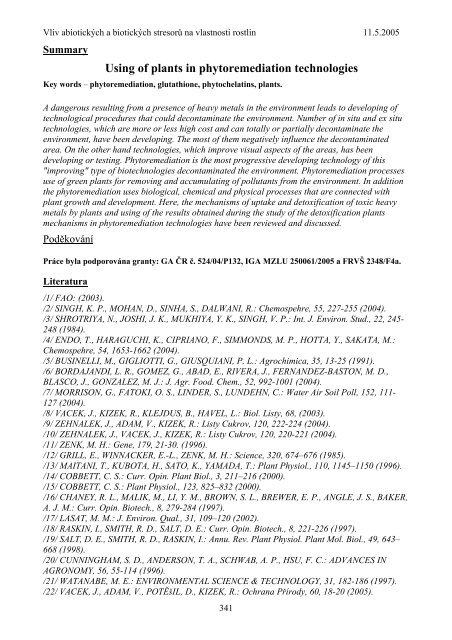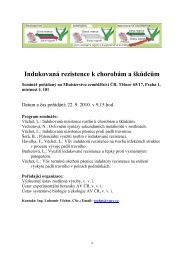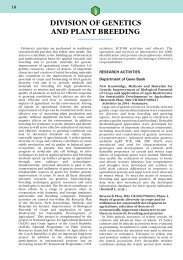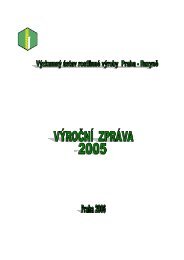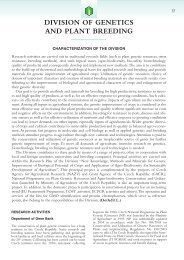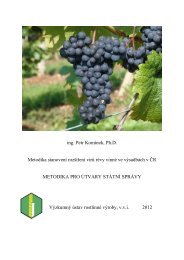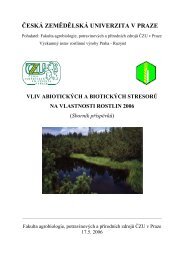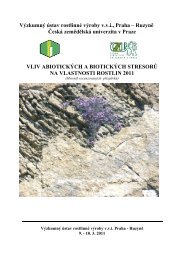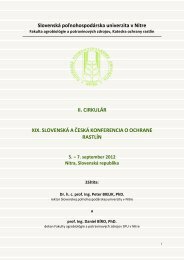LieÄÂivé rastliny v meniacich sa environmentálnych podmienkach
LieÄÂivé rastliny v meniacich sa environmentálnych podmienkach
LieÄÂivé rastliny v meniacich sa environmentálnych podmienkach
You also want an ePaper? Increase the reach of your titles
YUMPU automatically turns print PDFs into web optimized ePapers that Google loves.
Vliv abiotických a biotických stresorů na vlastnosti rostlin 11.5.2005<br />
Summary<br />
Using of plants in phytoremediation technologies<br />
Key words – phytoremediation, glutathione, phytochelatins, plants.<br />
A dangerous resulting from a presence of heavy metals in the environment leads to developing of<br />
technological procedures that could decontaminate the environment. Number of in situ and ex situ<br />
technologies, which are more or less high cost and can totally or partially decontaminate the<br />
environment, have been developing. The most of them negatively influence the decontaminated<br />
area. On the other hand technologies, which improve visual aspects of the areas, has been<br />
developing or testing. Phytoremediation is the most progressive developing technology of this<br />
"improving" type of biotechnologies decontaminated the environment. Phytoremediation processes<br />
use of green plants for removing and accumulating of pollutants from the environment. In addition<br />
the phytoremediation uses biological, chemical and physical processes that are connected with<br />
plant growth and development. Here, the mechanisms of uptake and detoxification of toxic heavy<br />
metals by plants and using of the results obtained during the study of the detoxification plants<br />
mechanisms in phytoremediation technologies have been reviewed and discussed.<br />
Poděkování<br />
Práce byla podporována granty: GA ČR č. 524/04/P132, IGA MZLU 250061/2005 a FRVŠ 2348/F4a.<br />
Literatura<br />
/1/ FAO: (2003).<br />
/2/ SINGH, K. P., MOHAN, D., SINHA, S., DALWANI, R.: Chemospehre, 55, 227-255 (2004).<br />
/3/ SHROTRIYA, N., JOSHI, J. K., MUKHIYA, Y. K., SINGH, V. P.: Int. J. Environ. Stud., 22, 245-<br />
248 (1984).<br />
/4/ ENDO, T., HARAGUCHI, K., CIPRIANO, F., SIMMONDS, M. P., HOTTA, Y., SAKATA, M.:<br />
Chemospehre, 54, 1653-1662 (2004).<br />
/5/ BUSINELLI, M., GIGLIOTTI, G., GIUSQUIANI, P. L.: Agrochimica, 35, 13-25 (1991).<br />
/6/ BORDAJANDI, L. R., GOMEZ, G., ABAD, E., RIVERA, J., FERNANDEZ-BASTON, M. D.,<br />
BLASCO, J., GONZALEZ, M. J.: J. Agr. Food. Chem., 52, 992-1001 (2004).<br />
/7/ MORRISON, G., FATOKI, O. S., LINDER, S., LUNDEHN, C.: Water Air Soil Poll, 152, 111-<br />
127 (2004).<br />
/8/ VACEK, J., KIZEK, R., KLEJDUS, B., HAVEL, L.: Biol. Listy, 68, (2003).<br />
/9/ ZEHNALEK, J., ADAM, V., KIZEK, R.: Listy Cukrov, 120, 222-224 (2004).<br />
/10/ ZEHNALEK, J., VACEK, J., KIZEK, R.: Listy Cukrov, 120, 220-221 (2004).<br />
/11/ ZENK, M. H.: Gene, 179, 21-30. (1996).<br />
/12/ GRILL, E., WINNACKER, E.-L., ZENK, M. H.: Science, 320, 674–676 (1985).<br />
/13/ MAITANI, T., KUBOTA, H., SATO, K., YAMADA, T.: Plant Physiol., 110, 1145–1150 (1996).<br />
/14/ COBBETT, C. S.: Curr. Opin. Plant Biol., 3, 211–216 (2000).<br />
/15/ COBBETT, C. S.: Plant Physiol., 123, 825–832 (2000).<br />
/16/ CHANEY, R. L., MALIK, M., LI, Y. M., BROWN, S. L., BREWER, E. P., ANGLE, J. S., BAKER,<br />
A. J. M.: Curr. Opin. Biotech., 8, 279-284 (1997).<br />
/17/ LASAT, M. M.: J. Environ. Qual., 31, 109–120 (2002).<br />
/18/ RASKIN, I., SMITH, R. D., SALT, D. E.: Curr. Opin. Biotech., 8, 221-226 (1997).<br />
/19/ SALT, D. E., SMITH, R. D., RASKIN, I.: Annu. Rev. Plant Physiol. Plant Mol. Biol., 49, 643–<br />
668 (1998).<br />
/20/ CUNNINGHAM, S. D., ANDERSON, T. A., SCHWAB, A. P., HSU, F. C.: ADVANCES IN<br />
AGRONOMY, 56, 55-114 (1996).<br />
/21/ WATANABE, M. E.: ENVIRONMENTAL SCIENCE & TECHNOLOGY, 31, 182-186 (1997).<br />
/22/ VACEK, J., ADAM, V., POTĚšIL, D., KIZEK, R.: Ochrana Přírody, 60, 18-20 (2005).<br />
341


